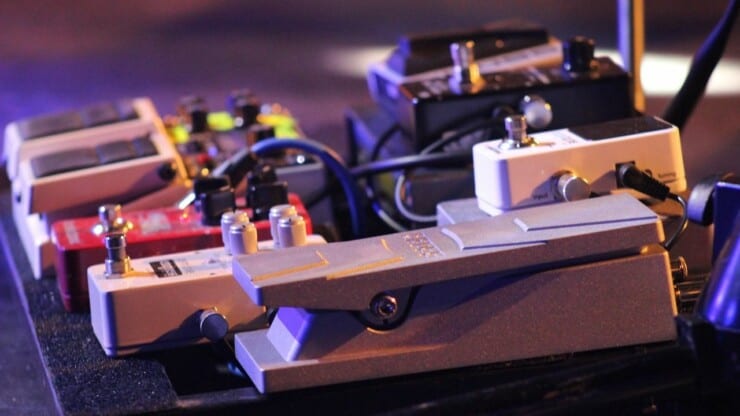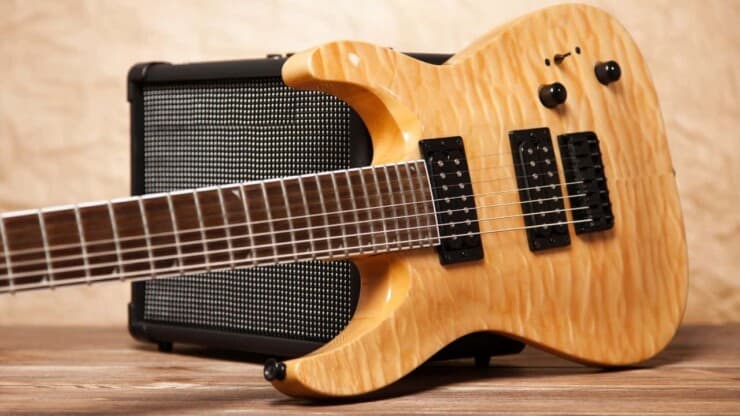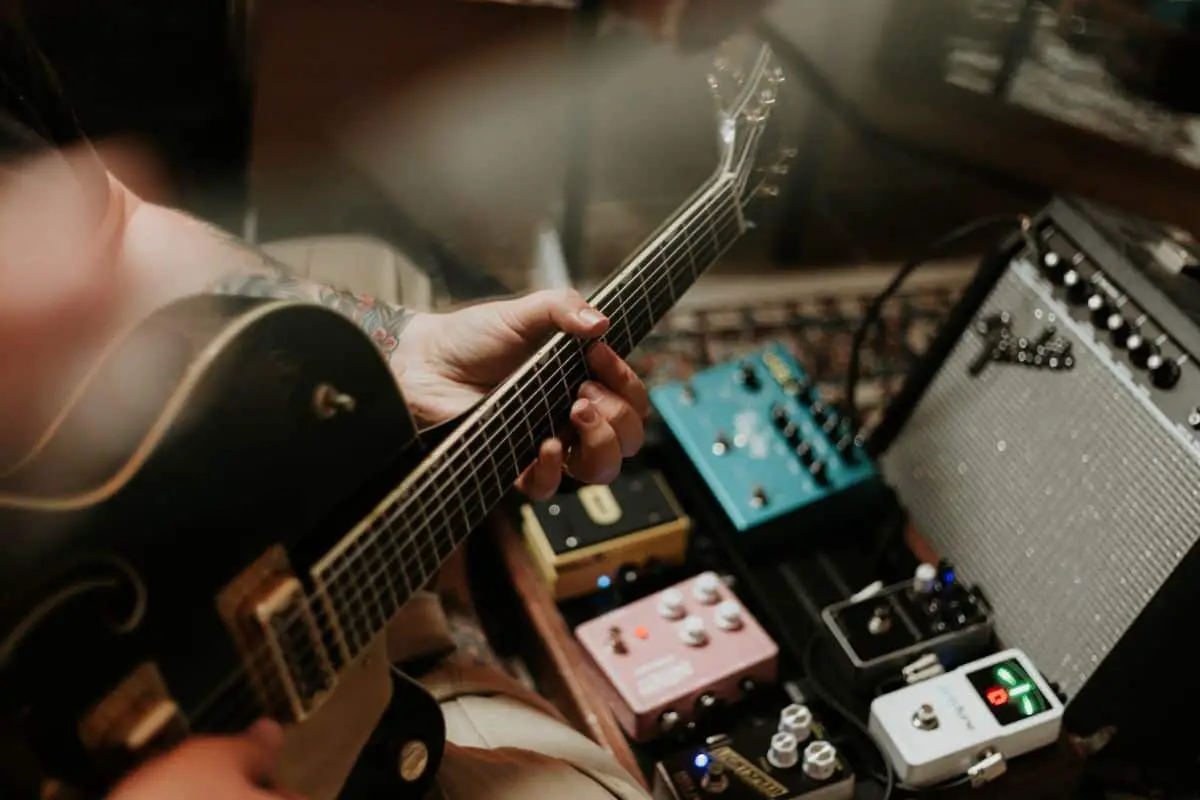Are you learning your way around a guitar amp, but struggling to come to terms with drive on amps? If so, then you’ll be glad that you found this article.
Drive means on a guitar amp, the gain for an amp or effects unit. Drive pedals consist of overdrive, distortion, fuzz, etc. and it helps you achieve a more aggressive broken-up tone. It’ll get your amp to sound anything from a little grit when hitting the string, all the way to getting the bees in a jar tone.
In this article, you’ll get to know all about drive, what does drive mean on a guitar amp, the difference between gain and drive, clipping in drive, what are drive pedals for guitar amps, and more. Continue reading to know the answers to all the questions you have about drive.
What does drive mean on a guitar amp?
Drive refers to the gain for an amp or effects unit and pushing the amp’s preamp for causing overdrive. Overdrive is usually considered to be another word for clipping or distortion. When you’re overdriving something with too much level, it’ll end up distorting. When you’re overdriving the amp with too much level, it’ll distort. For guitarists, there’s a distinction between distortion and overdrive. In the domain of guitar sounds, distortion largely means extreme distortion. It is commonly associated with the buzzing or “fuzz” type of sound. For guitarists, overdrive represents the guitar equivalent of the mechanical definition.
Why drive pedals are a necessity for a guitarist?
There are certain pedals that are considered to be must-haves and are normally one of your first pedal choices. The three pedals that many guitarists considered to be must-haves are drive pedals, delay pedals, and tuner pedals. Your guitar rig cannot outgrow these pedals. In case you want to take things a step further, you can consider wah pedals and compressor as essential too. The right pedals for your rig will depend on the tone you want, the music you’re playing, and your budget.
Say that you were to take a batch of guitarists and compare their pedalboards. You will notice that models and brands of pedals might change, but certain pedals will be the same. There are certain guitar pedals that you will always find incredibly useful. The last thing that you’d want is to purchase your first pedal and feel like upgrading it a couple of months from now.
The most common type of pedal that you’ll be using on a pedalboard after a tuner is the drive pedal. Unless you’re playing a style of music that is only using crystal-clean tones, a drive pedal will be highly recommended. Drive pedals will allow you to dial in different tones that your guitar amp might not be able to produce on its own. Even if you love the sound of your guitar amp’s drive channel, adding a drive pedal into the picture will be a great way of taking your sound in new directions.
A transparent overdrive pedal is the drive pedal that doesn’t color the tone dramatically. In simple words, you’ll get a drive sound out of your pedal. However, the pedal doesn’t completely change the tone to sound like a different type of guitar. It’s still your tone, but only cranked up. One of the reasons why a transparent overdrive pedal is an incredibly popular choice is because you’re highly unlikely to grow out of it. The pedal won’t color the tone, so even as the tone tastes change, the drive pedal will still suit you.
The most popular choice for guitarists looking for a transparent overdrive pedal is the Soul Food by EHX. However, this drive pedal has been around for a long time, yet it still happens to be a popular choice. It will sound great on its own, but it’ll also do a wonderful job when you blend it with the amp’s drive sound. The important point here that you should keep in mind is that a drive pedal is among the first few pedals to consider. Most guitarists see them as essential, even if you already like your guitar amp’s drive tone.
Different types of drive pedals for your guitar amp setup
Some guitarists use a drive pedal for giving their solos a boost, some use it for smoothing out the distortion, while others use it as the only drive sound. A high-quality drive pedal could last a lifetime and it can be incredibly useful. There are two different types of drive pedals that you can get – distortion and overdrive. They’re both similar, and the difference will just be in the technical details.
Overdrive pedal
Overdrive is used for referring to the sound created by a tube amp that gets pushed to its operating limit. The purest overdrive sound will come from a maxed-out tube amp. However, as not many guitarists blast their audience with high volumes, they prefer using stompbox effects pedals for creating overdrive.
Generally, overdrive is considered to be a particular form of distortion created by pushing the amp past its maximum capability to produce a clean tone. The reason achieving overdrive in tube amps is so easy is because of the tube amp’s design. The nature of the tube amp design is that it can sound clean at lower volumes and distort to an extent at louder volumes. While it’s true that there are many overdrive stompbox options out there, the effect these devices look for is that of an amp that is cranked past its clean tone capability.
Distortion pedal
Distortion is used for referring to the overall effect of altering the audio signal. The audio signals are made rougher with greater harmonic saturation more sustain, and more audible overtones than a clean signal. An overdrive tube amp can easily create distortion. However, in the world of effects pedals, distortion pedals are a bit more intense compared to overdrive stompboxes.
For everyday purposes (practicing, rehearsals, gigs), it helps to consider distortion as the umbrella term for any dirty guitar sounds. It’s the case regardless of what is causing it, be it a torn speaker, a rack effect, a stompbox, or an amp cranked up well past its capacity to produce a clean sound. In simple words, distortion can be stated as any signal that is not clean.
The main difference between overdrive and distortion is that distortion usually produces the same amount of distortion regardless of volume. Meanwhile, overdrive functions similar to tube amps, as it produces cleaner tones at low volumes and distortion at high volumes.
How to use drive pedals on a guitar amp?
You’ll have no trouble understanding how to use a drive pedal if you know what is a drive pedal. A drive pedal, be it overdrive, distortion, or fuzz, will help you achieve a more aggressive, broken tone. It can sound like anything from a slight dose of grit when hitting the strings hard all the way to the “bee’s in a jar” tones.
The approach to use drive in the past was to run your amp loud so that it was overdriving naturally. Then, you had to use the guitar’s volume control for reducing the gain for clean hits. Lastly, you had to hit overdrive to get even more overdriven tones by reducing the low-end and boosting the mids. Gear like Distortion Plus or Tubescreamer was perfect for this type of approach.
These days, it isn’t possible to run 100W Marshall amps at insane volumes, which leaves the guitarists with two approaches.
The first approach consists of using a different pedal for each need. For instance, you could run a clean amp and have a pedal for low gain. Have one for the medium gain, another one for higher gain, and another one for fuzz tones. You can even turn on two drive pedals at once for producing a higher gain tone. Using something like the King of Tone by Analog-Man will be a great example of having two pedals in one.
Most guitarists set one pedal aside as a low gain and the other one as a medium gain, while running them together for higher gain tones. The benefit to this approach is that you’ll save a lot of space on your pedal board. Meanwhile, the three tones will share a tonal characteristic, which is often preferable from the audience’s listening perspective.
The other method involves running two drives but leaving one of them “always on”. It’ll act as the drive tone. Choosing the right drive pedal will be more fundamental here than any other setup. The pedal that you’re choosing as your main drive needs to be dynamic enough such that when you roll down the guitar’s volume control, the pedal should clean up nicely.
A great overdrive pedal for this will approach would be the Analog Alien Bucket Seat. It has more than enough gain to get you high gain notes. Moreover, it has been designed specifically for cleaning up nicely like a real amp.

The second drive pedal in this approach would be a pedal like a Tubescreamer or a Klon-type pedal. Both of them will give you a remarkable, light drive and mid-push in different places. You can try them and decide which sounds best depending on your guitar rig. Alternatively, you can even try out an entirely clean boost like the Power Pack Boost. If it is placed after the drives, it’ll simply take the tone and make it louder. However, if you run it in front of the drive pedals, you’re pushing more power into the drive, making it overdrive more.
How to get your drive pedals and amp to sound perfect at rehearsal and gigs?
Most guitarists have no problem dialing in drive pedals and amps and getting the perfect sound at home. However, everything sounds all wrong when they’ve to repeat the same thing at rehearsals or gigs. The solution is to get the EQ right at a proper gig volume. Otherwise, the top end will cut the audience’s heads off.
You’ll need to EQ the amp and your guitar rig to the particular environment. Generally, if you’re running louder, which is common at gigs or rehearsals, you’ll have to lower the treble and upper mids. All this just to ensure that your tone isn’t scythed enough to cut through the audience. Mids and treble could get harsh at higher volumes. This has a lot to do with how your ears perceive frequencies at certain decibel levels.
At higher volumes, your speaker will be in its optimum zone. It’ll be pumping out the decibels and working at its highest efficiency. This way, it can beam the sound outwards much more effectively.
If you’re running an amp really loud, it’s suggested that you should get someone in your band to go and stand where the punters will be to stand when doing a sound check. If you don’t get the EQ right at the proper gig volume, with someone standing where the audience stands to help you dial it in, all the top end will cut the audience’s heads off.
What is clipping in drive pedals?
Clipping means that the signal coming from the guitar is amplified. The very top and bottom of the waveform get chopped so that it starts sounding like the smoothness is gone. Moreover, there’s also a level of aggression that gets applied to it. All the differences in the components that should be the same have a cumulative effect on the pedal’s final sound.
The signal comes in and goes into the clipping section of the drive pedal’s circuit. The circuit only allows for a certain amount of voltage through. Depending on the type of drive pedal you’re using, some of them sound more open and bigger than others. For instance, something like a Hermida Audio ZenDrive will use Schottky diodes.
They’ll clip in a soft manner while not letting a lot of forward voltage go through. There are options that offer more hard clipping that may be a pair of LEDs, something like the Gunshot overdrive. It’ll let in more voltage through, but once it clamps down, it’ll clamp down very hard. What you’re trying to do here is replace within the pedal what is happening within a valve. You’re creating distortion, and you’re doing so by chopping the signals and making it more of a square wave than a sine wave.
What is the difference between drive and gain?
Gain is used to refer to the signal intensity at the input. Meanwhile, the drive is the effect that the guitar amp achieves after clipping the signal.
For understanding the difference between drive and again, you’ll first need to have a basic understanding of how amps work. For starters, every guitar amp has a preamp and power amp section. If you like, you’ll be able to use separate preamp and power amp devices too. But you’ll need both of them before you go into any kind of speaker cabinet.
The preamp has a couple of functions. Firstly, it’ll imply the otherwise weak signals of the electric guitar. Secondly, it’ll shape the tone. It’ll determine whether it’ll be clean, distorted, or something in between. Most of the basic controls will be on the amp itself, like channel volume, gain, and EQ.
A power amp will further amplify the processed signal. It’ll give the signal enough power such that it can drive the speakers. Moreover, it’ll also shape the tone a little, which is especially the case when using tube amps. The tubes of the tube amps add a bit of distortion to the tone.
Output volume
The output volume knob on a guitar amp will control the power amp. It’ll take the signal processed through the preamp and then amplify it before going into speakers. This control won’t change the main features of the tone that you’ve got with the preamp. It’s only supposed to make things a bit louder. However, things are slightly more complicated with tube amps. Pushing the volume higher will change the sonic characteristics

Input gain and how it is different from output volume
The gain is essentially a part of the preamp. It’ll increase the signal right at the start when it enters the preamp. The output volume or master volume will be at the end. It’ll take the signal as it’ll be from the preamp and will make it louder.
Understanding drive
The problem is that both guitarists and gear manufacturers use gain, drive, and distortion interchangeably. Drive and distortion are essentially the same things. However, having more gain does not always mean that you’ll have more drive. It’ll become less confusing once you know how to define drive.
Drive is the effect that is achieved through clipping. Clipping itself will be a result of the signal strength and the headroom of the guitar amp. The headroom here will be how much you’re able to turn your amp up without getting drive. With increased signal intensity and amplitude, you’ll get the “clips” or “cuts”. There are three different kinds of clipping that determine the type of drive you’re having –
- Soft clipping – Overdrive (like in Ibanez Tube Screamer)
- Harsh clipping – Regular distortion (like in Boss DS-1)
- Extreme clipping – Fuzz (like in Dunlop Fuzzface)
Guitar drive pedals achieve these effects through a deliberate clipping process. They’ve got operational amplifiers (op-amps) in them to increase the signal amplitude. Then diodes or transistors will clip the signal and achieve distortion.
Gain vs. drive: The difference
As mentioned before, people always use terms like gain and drive interchangeably. However, they are not synonymous.
Gain is used for referring to the signal intensity at the input. When talking about gain, it’s used to refer to the preamp gain. As you start adding gain, the output will get louder. However, it’ll all depend upon the amp’s headroom. If the gain is increased enough for hitting the headroom of an amp, you’ll get clipping. Once you’ve got clipping, you’ve got distortion or drive.
Drive or distortion is essentially an effect. It is a sonic result of the entire process of signal clipping. You’ll be able to achieve it by adding more gain only if you’ve hit the headroom limitations. However, it does not just end there. If you continue increasing gain after hitting the headroom, you wouldn’t be able to increase the output volume anymore. Instead, the sound will get harsher or more distorted.
If you want to get louder, you’ll have to increase the output volume. This control will be a part of the power amp section. It’ll take the signal as it gets processed within the amp and then make it louder. However, tube amps will add distortion in the power amp section too. They normally come with comparatively smaller headroom.
For instance, you can try to take a low wattage amp, put on a clean channel, and increase the master volume. The signal hits the headroom far quicker, and you’ll get added distortion in the power amp section.
Conclusion
Thank you for reading. Hopefully, now you know a lot more about drive, what does drive mean on a guitar amp, the difference between gain and drive, clipping in drive, what are drive pedals for guitar amps, and more. Drive refers to the gain for an amp or effects unit and pushing the amp’s preamp for causing overdrive. Drive pedals will allow you to dial in different tones that your guitar amp might not be able to produce on its own.



